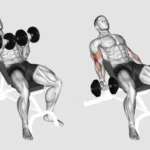Bicep Ladder Workout: Exercise Overview
The bicep ladder workout is a dynamic, progressive exercise designed to target the biceps brachii, with significant engagement of the latissimus dorsi, rhomboids, and core. Using a Smith machine, this workout involves performing inverted rows at increasing bar heights, gradually intensifying the challenge to build bicep strength and endurance.
Ideal as a progression toward mastering full chin-ups, the bicep ladder is excellent for developing pulling strength and achieving a deep bicep burn. It’s a versatile addition to arm-focused workouts, back sessions, pull routines, or full-body programs, suitable for lifters of all levels aiming to enhance both functional and aesthetic upper-body strength (Schoenfeld, 2010).
How to Perform the Bicep Ladder Workout
- Set the Smith machine bar low enough to lie underneath it with arms fully extended, grasping the bar with a supinated (underhand) grip, hands shoulder-width apart.
- Position your body in a straight line from head to heels, engaging your core and glutes to maintain a plank-like posture—this is your starting position.
- Perform an inverted row by pulling your chest toward the bar, flexing your elbows and squeezing your biceps and back muscles at the top.
- Lower yourself back to the starting position with control, maintaining tension in your biceps.
- Complete the designated number of reps, then raise the bar one notch to increase the angle and difficulty, and repeat the inverted row.
- Continue moving the bar up notch by notch, performing reps at each level, until you reach maximum effort or perform full hanging chin-ups.
- Repeat for the desired number of sets or until you achieve a complete bicep burnout.
Tips for Optimal Performance
- Maintain a Rigid Body: Keep your body straight and core braced throughout to avoid sagging hips or excessive spinal movement, ensuring proper muscle engagement (McGill, 2010).
- Control the Movement: Perform each rep slowly to maximize bicep and back activation, avoiding momentum to enhance the mind-muscle connection (Schoenfeld, 2016).
- Squeeze at the Top: Pause briefly at the top of each row to intensify the bicep contraction, especially as you progress to higher bar positions.
- Progress Gradually: Start at a lower bar height to master form, and only advance to higher notches or chin-ups as your strength and stability improve (Wirth et al., 2016).
- Breathe Properly: Exhale as you pull toward the bar and inhale as you lower back down to support core stability and muscle oxygenation.
- Aim for Burnout: Push to complete as many notches as possible to achieve a full bicep burnout, but prioritize form to avoid injury.
Powering up biceps and back with ladder workouts? Discover their place in our Ultimate Guide to Muscle Groups.






